Featured Golf News
Golf in Beautiful New Zealand
I'm no logician, but I figured the best way to learn about New Zealand golf was from a Kiwi who also happened to be a golfer. Luckily I stumbled into a good one in the tiny burgh of Kinloch, near beautiful Lake Taupo, in the geographic center of New Zealand's North Island. Phil Tataurangi is a PGA Tour winner and native New Zealander of Maori descent. Other than 2005 U.S. Open champion Michael Campbell and 1963 British Open champion Bob Charles - among the most successful left-handed golfers in history, Tataurangi is certainly among the most successful New Zealand-born players in recent memory.

Gulf Harbour
"Our country is still a great unknown in the world of golf travel," begins Tataurangi, who turned professional in 1993. "People from the Northern Hemisphere have a tough time even finding New Zealand on a map. But we are so diverse geographically in an area about the size of Colorado, but shaped like California. We are just a couple of small islands in the middle of the Pacific, but we differ from the other Pacific islands in that we have so many different landscapes, so many activities, golf among them. We have dozens of small countryside golf courses played by the locals, but what attract the international visitor are the marquee courses that have for the most part come into being in recent times."
On the more populous North Island, the marquee courses Tataurangi refers to include Kauri Cliffs - which is to the far north, Titirangi and Gulf Harbour - both in the Auckland suburbs, Kinloch and Wairakei near Lake Taupo near the island's center, Paraparaumu Beach - way down towards Wellington, and first and foremost, the scintillating Cape Kidnappers near Napier. More on that world-beater a little bit later.
Cosmopolitan Auckland is home to fully one-third of New Zealand's nearly four-and-a-half million citizens. It's a gorgeous city, surrounded by water, filed with sailing vessels and with great architecture, shopping, culture, food and nightlife. The golf is sterling also, with examples such as the classic Titirangi, designed by the renowned Alister MacKenzie, who also created Augusta National and Cypress Point.
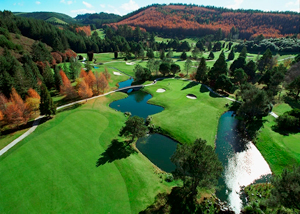
An Aerial View of Wairakei
"Titirangi features all sorts of native bush, so even though it's not far from Auckland, in the middle of suburbia, it has a sense of remove," offers Tataurangi, who won the 2002 Invensys Classic at Las Vegas. Gulf Harbour, a much newer venue created by Robert Trent Jones Jr., is also relatively close to the city. This former New Zealand Open site features some wonderful close-up water views toward round's end, and some dramatic elevation changes. But the disjointed housing element is notable throughout the round, detracting a bit from an otherwise-gripping golf experience.
Both courses are easily accessed by staying downtown at the Langham Hotel, one of Auckland's more prestigious lodgings, featuring several gourmet restaurants, a full-service spa and a fine location. It's not only an easy walk or shuttle to the downtown area, but it's also in close proximity to the main motorway, allowing easy access to the fine golf venues in the nearby suburbs.
About four hours south of the city is Lake Taupo, which looks and sounds like Lake Tahoe. The biggest difference between the two is that one can actually swim in the former, while the alpine setting of the latter precludes anyone not in the local "Polar Bear Club" from braving the frigid waters of the famed lake on the Nevada-California border. New Zealand in general is an adventurer's paradise and the sports-and-outdoor scene in and around the town of Taupo crystallizes this sensibility. Coming to this wonderful country exclusively to play golf is a bit like going to Las Vegas just to gorge on buffets. It can be an important part of the experience, but focusing exclusively in that one area means far too much is overlooked.
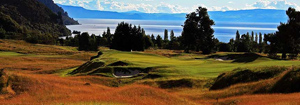
Kinloch Club
Just a limited laundry list of other attractions would include beautiful beaches, world-renowned wineries, deep-sea fishing, hiking, caving, bungee-jumping, kayaking, rappelling (or "abseiling," as it's referred to there), sailing, underwater caving, mountain biking, volcanic and geothermal touring, Maori culture, float planes, fine dining and dozens of other activities involving sports, arts and culture. And among the fine golf courses found near Taupo, there is the older, well-established Wairakei, and the new kid on the block, Kinloch.
"Wairakei is an iconic New Zealand experience," continues Tataurangi, who also has won on the Nationwide Tour. "It's right on the main line, the major roadway connecting Auckland to Taupo, and every golfer in the country is aware of it. The Punga (sometimes known as Ponga) wall fences on the course are the Kiwi's answer to Pete Dye's railroad ties. The golf course has been returned to something of a bird sanctuary, with a very imposing fence to keep out predatory animals, and to resurrect the natural wildlife that used to abound on the site."
While Wairakei is front and center, just off the highway, it takes a few twists and turns in the road to find Kinloch, but the extra effort is richly rewarded.
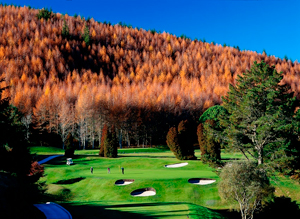
Wairakei Offers Astonishing Beauty
Wairakei is a traditional-looking parkland golf course, and the feel and landscape is similar to numerous courses stateside. But Kinloch is a different animal altogether. The only flat lie is on the tee box, and the playing fields are surrounded by a gorgeous green hillside that screams "Ireland" as much as it does New Zealand.
"Kinloch is one of our newer courses and the designer speaks for himself," states Tataurangi. "Jack Nicklaus has been coming to New Zealand for years to fish, so he was finally able to combine business with pleasure and design a golf course here. From the back tees it's all the challenge you could want. It's a links-like experience in the middle of the country, surrounded by these massive and beautiful hills. It's hard, firm, bouncy, you play the angles, it's full of wind-blown bunkers and sheep ruts, where the sheep burrow into the side of the hill to escape the wind. All that burrowing causes a berm-like effect, and with all the elevation changes, the long view of Lake Taupo on the inward nine, it makes it one of the most distinctive golf properties in New Zealand."
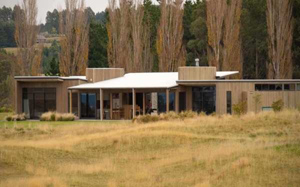
Dunalistair House at Kinloch
Speaking of distinctive properties, the Dunalistair House at Kinloch is one of the most unusual on-site lodgings one will encounter in all the world of golf. It is a sleekly modern, futuristic four-bedroom home, wall-to-wall glass, the only rental property on the 660-acre parcel. It's just a short-iron from the fourth tee and offers stunningly beautiful and expansive views of the hillsides framing the course. The house has been designed as a sustainable energy-saving property, which allows for real energy efficiency. The heating system and lights can be triggered remotely when clients are arriving, and the hall lighting is sensor-driven, so they go and off automatically when visitors are moving throughout the house.
Dunalistair House is owned by Alistair Tod, a Scotsman who decided to relocate to the Southern Hemisphere and raise his family in his wife Kirsty's native land. Besides the proprietorship of his namesake rental property, his company www.Greenfernz.com specializes in high-end, custom golf tours of New Zealand. "Many of my American clients have been to the UK and Ireland, and are looking for something new, and more adventurous," explains Tod, who moved to New Zealand in 2004.
"This country is so beautiful, and the golf courses are so diverse in terms of landscape. We can create an incredible golf itinerary throughout the country, on both islands. Most people are very surprised at the quality of courses we offer at the upper tier. Not just the well-known North Island destination like Kauri Cliffs and Cape Kidnappers, but also on the South Island at places like Jack's Point, The Hills, and some of the other courses around Queenstown. In the last decade or so the bar has really been raised."

Looking Down on the
Spectacular Cape Kidnappers
It's not just the bar, but as the roadway elevates, expectations are raised to the heavens as the fortunate golfer makes their way to Cape Kidnappers, one of the most rousing experiences in the southern, or any other hemisphere. There are some famous drives in golf, Magnolia Lane at the Augusta National and 17-Mile Drive on the way to Pebble Beach chief among them.
But the eight-kilometer snaking, circuitous climb to Cape Kidnappers is the most pulse-pounding by far. Just those 10 minutes in a car (exacerbated by motoring on the left, or the "wrong" side of the road) makes the drive itself more exciting than at least 500 golf courses this correspondent has seen previously. So torturous and meandering is the roadway to Cape Kidnappers, it makes the twisting roundabout of 17-Mile Drive seem as simple and clear-cut as the ruler-straight, relatively short drive down Magnolia Lane.
"Cape Kidnappers is our best golf course by far," asserts Tataurangi. "Tom Doak is one of the emerging architects of our time and it's a spectacular property. I think the architecture is above most golfers' comprehension, to be honest, but the experience is something else."
Aerial images of the property, though spectacular, only tell part of the story. Yes, the entire Cape Kidnappers property encompasses some 6,000 acres, as it remains, despite the five-star lodge, award-winning cuisine and all-world golf course, a working sheep station. True, the seaside cliffs are some 500 feet above the super-sized greens, and the water of Hawke's Bay a delightful shade of iridescent blue. There are even bottomless-looking, death-defying chasms separating the fingers of land between back-nine golf holes, and if it wasn't for the sturdy picket-and-wire fence in place (not to mention the dire "Warning!" signs), it's easy to imagine a careless or distracted cart-driver plunging headlong into the abyss.
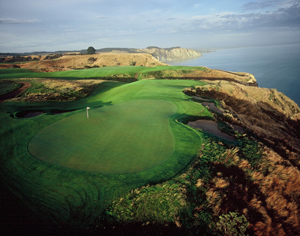
Cape Kidnappers is Out of this World
But despite the incredible eye-candy and once-in-a-lifetime location, it's the hole-by-hole strategy, the sight lines, playing options, conditioning and nuance of the golf course that truly makes Cape Kidnappers one of the world's best. Comparisons to Ireland's much talked-about Old Head are inevitable, but other than their respective stunning locales, they have little in common. To use an NBA analogy, one cannot discuss the good-but-not-great Ralph Sampson in the same sentence as the incomparable Wilt Chamberlain, despite the fact they were both seven-foot centers.
According to Doak, Cape Kidnappers is not true links terrain, despite its seaside locale, the firm and fast conditions, and the omnipresent wind. He cautions to be wary of severely yanking one's shot to the green on Nos. 6, 12 or 15. "It's possible to pull your approach off the very end of the earth," states Doak, only partially in jest. "Though if you do, it will take nearly 10 seconds of hang time for your ball to reach the ocean, 500 feet below. Enjoy your game and the setting, because you will never play golf somewhere like this again."
The one quibble regarding world-class golf in New Zealand, at least as it relates to the North Island (the golf thrills to be had on the less-populated South Island will have to wait for another day), is that the marquee venues are well-separated. Kauri Cliffs is well to the north of Auckland, Paraparaumu Beach well to the south, somewhere close to the capital city of Wellington, and Cape Kidnappers somewhat centralized between the two.
But if an interested party only has the time, resources and inclination to visit one of the "Big Three," Cape Kidnappers is the choice. It goes well beyond the fact that the facility is roughly in the middle. If you're at Cape Kidnappers you've really and truly hit the bull's-eye.
For information on great golf in New Zealand visit www.bestofgolfnewzealand.com.
For information on planning a custom trip to New Zealand visit www.greenfernz.com.
For information on all sorts of great adventuring off the golf course, particularly in the Lake Taupo Region, visit www.rapids.co.nz.
Joel Zuckerman, called "One of the Southeast's most respected and sought-after golf writers" by Golfer's Guide Magazine, is an award-winning travel writer based in Savannah, Ga., and Park City, Utah. He has written five books, including the epic "Pete Dye Golf Courses" in 2008. Joel's course reviews, player profiles, essays and features have appeared in more that 100 publications internationally, including Sports Illustrated, Golf, Continental Magazine, Travel & Leisure Golf, Sky Magazine, Golf Connoisseur, Golfweek, Estates West, Millionaire and Golf International. For more of Joel, visit www.vagabondgolfer.com.
Story Options
 |
Print this Story |
